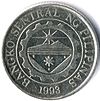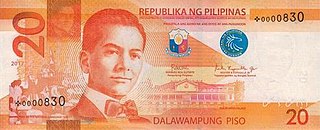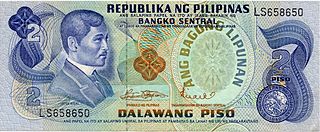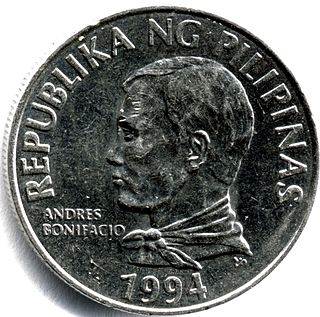History
When Martial Law was lifted in 1981, the Central Bank started to print and mint an entirely new series of Philippine currency notes and coins which are contemporary and forward looking, adopting the latest trend of anti-counterfeiting features. On June 12, 1985, the BSP issued the New Design Series starting with the 5-piso banknote with the face of Emilio Aguinaldo on the obverse side. The following month in July 1985, the 10-piso banknote with the face of Apolinario Mabini on the obverse side was issued. On March 3, 1986, a new 20-piso banknote was introduced, with the first 34 million banknotes have the signature of President Ferdinand Marcos despite being released days after the People Power Revolution. [1]
Before the 500-peso banknote with Benigno Aquino Jr. was printed, the version designed by Romeo Mananquil was to feature Ferdinand Marcos and was its reverse was to be the Batasang Pambansa Complex. The People Power Revolution caused it to be replaced by the current 500-peso banknote. Remnants of this version of the banknote were only for media purposes.
When the new 1987 Constitution was promulgated, the 50, 100, and 500-piso banknotes with the faces of Sergio Osmeña, Manuel Roxas, and Benigno Aquino, Jr. on the obverse side were introduced. On December 16, 1991, the BSP issued for the first time a 1000-piso banknote, containing on the obverse side the composite portraits of World War II heroes Jose Abad Santos, Josefa Llanes Escoda, and Vicente Lim.
After the creation of the Bangko Sentral ng Pilipinas in 1993, its new logo was incorporated on all the New Design series bills.
Two of the series' banknotes were stopped production and replaced by their more durable coin version due to the bills susceptible to wear and tear caused by widespread usage which are five and ten peso notes in 1995 and 2001, respectively. However, they remained common in circulation even after their printing stopped until 2004, and legal tender until December 31, 2015, and have a liability of the BSP and can be exchanged with their coin counterpart until the New Design Series' demonetization on January 3, 2018.
On May 2, 1997, the portrait of Andres Bonifacio on the ten-peso note was added beside Mabini, and elements from the Katipunan movement were added on the right side of the bill; one of the Katipunan flags and the Kartilya ng Katipunan. The design of the reverse was also changed. The scene from the Blood Compact of Katipuneros, previously featured in the Pilipino and Ang Bagong Lipunan series ₱5 bill was added on the right side of the Barasoain Church. However, the watermark area still only features Apolinario Mabini and the embedded security thread was on the right side of the signature of BSP governor until 1998 thus the notes with Andres Bonifacio from 1997 to 1998 uses the paper that would supposedly print the original 1985 version of the banknote with only Apolinario Mabini.
The year of printing was added at the bottom of the denomination value located at the upper left corner of the obverse starting with the release of the version of 10-peso note with Bonifacio in 1997, and then implemented on the rest of the series' banknotes in 1998 on 50, 100, 500, and 1,000-peso notes except the 5-peso note as it stopped printing in 1995 two to three years before the implementation of the printing year.
In 1998, the 100,000-piso Centennial banknote, measuring 8.5"x14", accredited by the Guinness Book of World Records as the world's largest legal tender note was issued in a limited quantity of 1000 pieces to commemorate the celebration of the Centennial of Philippine Independence. Along with this was the launching of the 2000-piso Centennial Note, measuring 216 mm x 133 mm and bearing the signature of President Joseph Estrada, on December 1, 1998.
In 1999, the names of the signatories on the bills were added starting with banknotes featuring the signature of President Joseph Estrada. During the Estrada Administration, the practice in use since the Commonwealth, of reproducing the signature of the President of the Philippines over the legend "President of the Philippines" was abandoned in favor of explicitly stating the president's name. Also, the names of signatories are capitalized, while the position are now in lowercase.
Meanwhile, in the latter part of 1990s, colored reproduction machines became available in commercial quantity and has become a big threat to the integrity of the currency. As a result, in 2001, BSP decided to enhance the security features of the of 1000, 500, and 100 peso banknotes (with 500 and 100 peso starting with the signature of President Gloria Macapagal Arroyo), including the 200-piso which was issued on June 12, 2002, by incorporating the iridescent band and the windowed security thread to combat counterfeiting made out of colored copiers. On that same year, the name of the Old Legislative Building (Dating Gusali ng Batasan, with the name was located at the lower-left side) on the reverse side of the fifty-peso note was changed to the "National Museum" (Gusali ng Pambansang Museo) and the name was moved at the top of the building, to reflect the turnover made by the Congress of the Philippines to the National Museum. The name of the building's facade was changed from "Executive House" to "National Museum". Also, the serial number was moved at the top of the denomination that was located on the lower left side of the banknote.
The second major political upheaval called EDSA II in 2001 was depicted on the reverse side of the 200-piso showing Gloria Macapagal Arroyo being sworn into office at the EDSA Shrine. She is the first president whose image has been included in a banknote while in office. On the obverse side of the banknote is the portrait of his father, Diosdado Macapagal. The 200-piso NDS which was issued in 2002, with it being the last denomination to be added in the series. It was also a commemorative banknote, released on June 12, 2002, to commemorate the 104th anniversary of Philippine independence. Its release also coincided the 17th anniversary of the launching of the New Design Series and five-peso note on June 12, 1985, which also featured Aguinaldo Shrine and colored green, and was still common in circulation even after its production stopped in 1995 (seven years before the release of the 200-peso note) when the latter was released in 2002.
The 200-peso banknote was the subject of criticism by the opposition. They said that the legal tender should only feature deceased national heroes and not an incumbent president. Although, it wasn't the first time that a legal tender featured a sitting president. Legal tender coinage was minted to commemorate the inauguration of Manuel L. Quezon as President of the Philippines in 1935. Emergency currency during World War II had many instances where provincial emergency currency boards placed the image of then President Manuel L. Quezon. In 1975, Bangko Sentral ng Pilipinas released a 5-peso coin featuring the face of then President Ferdinand Marcos. Former presidents Fidel Ramos and Joseph Estrada was also pictured in a limited commemorative 2000-peso banknote that honors the 100-year celebration of Philippine Independence. Also a limited commemorative gold 1000-peso banknote with the picture of former President Joseph Estrada was also issued to honor the 100-year celebration of Philippine Independence. Also, every banknote series since 1935 has borne the facsimile signature of the incumbent President of the Philippines.
Some critics including Father Robert Reyes also pointed out that featuring Gloria Arroyo in the 200-peso note could be an electioneering tactic ahead of the 2004 Philippine elections. [2]
The one hundred peso banknote became the subject of controversy in 2005 after banknotes printed by Oberthur Technologies of France in time for the Christmas season and upon the release of banknotes featuring the signature of BSP governor Amando Tetangco Jr. were printed with the President's name misspelled, the first in Philippine history. The banknotes spelled the President's name as "Gloria Macapagal-Arrovo" versus the correct Gloria Macapagal Arroyo. The incident was subsequently the subject of public humor as soon as the issue made national headlines. The BSP probed the mistake and corrected the error afterwards. [3]
On August 16, 2009, a proposal was made by the Bangko Sentral ng Pilipinas to have former President Cory Aquino accompany her husband, Ninoy Aquino on the banknote. The new design was included in the 500-peso New Generation Currency (NGC) note.
The NDS banknotes were printed until 2013 (with 5-peso note were printed until 1995, 10-peso note until 2001, 20 and 1000 peso notes until 2012, and 50, 100, 200 and 500 peso notes until 2013), legal tender until December 31, 2015, and can be exchanged with newer notes until the series' demonetization on January 3, 2018. The NDS co-existed with NGC banknotes from December 16, 2010, to January 3, 2018.
The NDS/BSP notes were no longer legal tender since January 1, 2016 and demonetized two years later on January 3, 2018, pursuant to BSP Circular No. 954, Series of 2017, after the BSP allowed the public to swap their old banknotes for the NGC but only those who secure a receipt showing that they went to the central bank before the December 29, 2017 final deadline of submission due to not being able to accommodate several individuals who tried to exchange their notes because of the unexpected number of people who arrived (originally scheduled by January 1, 2017). [4] [5] [6] [7]
Design of the banknotes
5-peso banknote
Colored green, the 5-peso note was designed by Romeo Mananquil. The obverse of the 5-peso banknote featured the portrait of Emilio Aguinaldo. Along the right side of the banknote was the NHCP historical marker in the Malolos Cathedral (indicating the foundation of the First Philippine Republic, which Aguinaldo became its president) along with a cannon. The reverse of the banknote featured a depiction of the Philippine declaration of independence by Emilio Aguinaldo on June 12, 1898. Security features of the banknote included a security thread, scattered red & blue visible fibers, and fluorescent printing.
10-peso banknote
Colored brown, the 10-peso banknote designed by Rafael Asuncion was issued in July 1985, a month after the 5-peso banknote was issued. The obverse side of the 10-peso banknote featured Apolinario Mabini on the left and Andrés Bonifacio on the right. Bonifacio was the founder of the Katipunan (KKK), a secret society established to fight the Spanish colonial government. Mabini was the Philippines' first Prime Minister and Secretary of Foreign Affairs. Depicted on the right side was one of the flags of the Katipunan (see Flags of the Philippine Revolution), the Kartilya ng Katipunan, and the manuscript of El Verdadero Decalogo (The True Decalogue) written by Mabini along with the quill and inkwell. The reverse side of the banknote featured the Barasoain Church in Malolos, Bulacan, site of the first Philippine Congress and where the Malolos Constitution was drafted. The right portion depicted the initiation rites of the Katipunan. Members accepted into the society had to sign their name on the society's roster using their own blood. The design was previously used on the 5-peso "Pilipino" and "Ang Bagong Lipunan" notes. From its introduction in July 1985 until May 2, 1997, the 10-peso banknote only depicted Mabini and the Barasoain Church.
20-peso banknote
Colored orange, the 20 peso bill was designed by Angel Cacnio. The obverse side of the 20-peso banknote featured Manuel L. Quezon, first president of the Commonwealth of the Philippines. Along the right side of the banknote was the coat-of-arms of the Commonwealth, and two of Quezon's notable accomplishments. The first was "Wikang Pambansâ", which is Tagalog for "national language". In 1937, the National Language Institute was founded to establish a single national language for the Philippines. This eventually became the Filipino language, which is largely based on Tagalog. The second was the "Saligang Batas 1935" or the 1935 Constitution of the Philippines. This was the first real constitution that was nationally effected and large parts of it survive in the current constitution. The reverse side of the 20-peso banknote depicted Malacañan Palace, more popularly known as Malacañang, the residence of the President of the Philippines, along the banks of the Pasig River. Quezon was the first Philippine president to live in the Palace.
50-peso banknote
Depicted on the front side of the fifty-peso was Sergio Osmeña, the second president of the Commonwealth of the Philippines. He served as president from 1944, after Quezon's death, to 1946, when the United States granted the Philippines' independence. The banknote was predominantly colored red and was designed by Rafael Asuncion. The National Museum was featured on the reverse side of the banknote. This building used to be the Legislative Building, where the House of Representatives that Osmena presided over as Speaker from 1907 to 1922 was located. The building and then renamed Executive House during the Martial Law period and was labeled as such in the fifty-peso banknote until recently.
100-peso banknote
The front side of the 100-peso banknote featured Manuel Roxas, the first president of the independent Philippine Republic. This independence was shown at the right side where the Philippine flag was raised while the flag of the United States was lowered on July 4, 1946. The banknote was predominantly colored violet and was designed by Angel Cacnio. The reverse side of the banknote depicted the Manila compound of the Bangko Sentral. The 100-peso banknote was the smallest-valued banknote to have the new security features implemented in recent years. But before the advent of the new security features, the 100-peso banknote was interesting for having other security features. On the front side was a barely visible "100" text above the signatures of the president and the Central Bank governor. This text was best seen on crisp new 100-peso banknotes. On the reverse side, the top row of windows of the main building had the words "Bangko Sentral ng Pilipinas" ("Central Bank of the Philippines") running the whole length.
500-peso banknote
Colored yellow, the front side of the 500-peso banknote featured the portrait of Benigno Aquino Jr. To the right of the banknote, there were two popular quotes from Aquino: "Faith in our people and faith in God" (which is located above the signature of the Philippine president), and "The Filipino is worth dying for", under which was signed his nickname, "Ninoy". There was also the signature of Aquino, a typewriter with his initials ("B.S.A.J."), and a dove of peace. A Philippine flag was also to the right of his portrait, near the central part of the front side. The reverse side featured a collage of various images in relation to Aquino. He was (in front of an article about "1st Cav", out of some of the pictures) a journalist for the Manila Times , a senator (the pioneer of the Study Now, Pay Later education program), the mayor in his hometown of Concepcion, the governor of Tarlac, and was the main driving force behind the People Power Revolution of 1986, [8] [9] some three years after his death in 1983. It was also interesting to note that unlike the names of the figures on the bills, "Benigno S. Aquino, Jr." was written in gold-colored, cursive writing with a green laurel wreath as opposed to the name being simply written as with the other banknotes.
1,000-peso banknote
Colored blue, the front side of the 1,000-peso banknote featured the portraits of José Abad Santos, Chief Justice; Josefa Llanes Escoda, civic worker and one of the founders of the Girl Scouts of the Philippines; and Vicente Lim, a general in the Philippine Army, first Filipino graduate of West Point: the three are considered heroes of the resistance against the Japanese occupation of the Philippines. It also featured the eternal flame at the Libingan ng mga Bayani , laurel wreath, and Bangko Sentral ng Pilipinas (BSP) logo. The back of the banknote featured the Banaue Rice Terraces, Manunggul Jar cover and Langgal. It was designed by Romeo Mananquil. Security features of the banknote included optically variable ink, a security thread, scattered red & blue visible fibers, and fluorescent printing. The words "Central Bank of the Philippines" were microprinted in the lower left border on the face of the note.
































